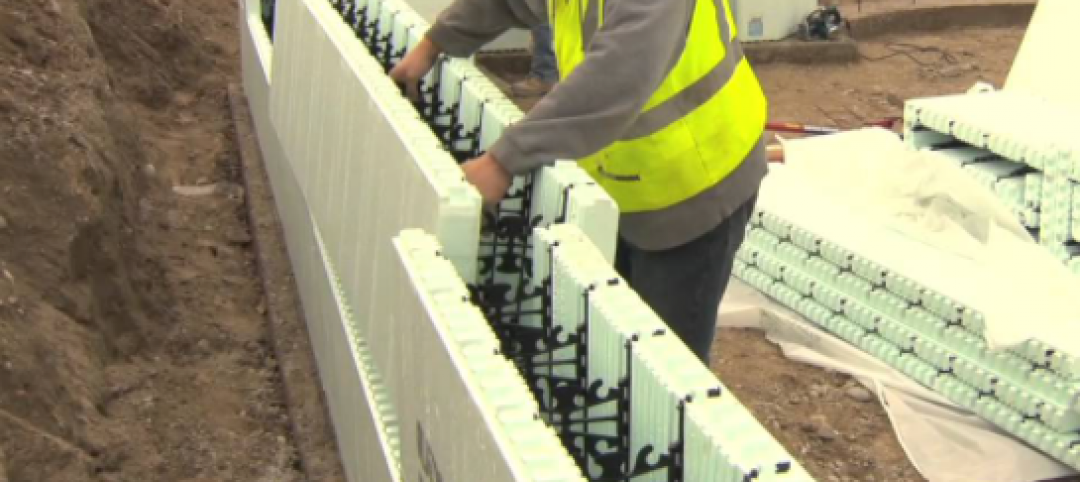Liberty University’s $500 million campus rebuilding project is designed to provide current and prospective students with an array of living, learning and experiential opportunities and facilities that enhance the overall student experience. Ensuring that student residences were maximizing energy efficiency with comfortable living spaces and contributing to how the university manages energy consumption, the recent completion of a nine story student residence hall, the first of six, was wrapped in a high-performance medium-density spray foam insulation product from Icynene. The decision to wrap the new residence halls in high performance spray foam insulation follows the university’s energy conscious approach where energy efficiency planning begins from the design and development phase.
In the lead up to developing the new residence halls, the university took the opportunity to listen and respond to students. With more than 13,200 resident students expected in the 2014-2015 academic year, the sense of community was equally as important as the individual. The university sought to establish community spaces where students could interact, engage and study with their friends and peers. Furthermore, the university’s stance toward responsible stewardship also meant a proactive approach to energy efficiency and sustainable materials was important.
The project included replacing the original 16 Champion Circle residence halls built on the same site in the 1970s; the first of the new student residences – Residential Commons I – was on schedule to be operational in time for the start of the 2014-2015 academic year. Residential Commons I was designed to house 1200 students in a two bed-one bathroom per room configuration, enough to replace all of the original residence halls. 
With the tight construction schedule, a daily crew of 60 to 100 contractors worked to erect the steel framing, wall panels, floor slab and insulate the building to complete the project on time. High-performance spray foam insulation was specified to achieve optimal thermal comfort while help better manage energy use. Licensed Icynene contractor, AC&R Insulation of Elkridge Maryland, was recruited to insulate and air seal the residence hall in a continuous insulation application whereby Icynene MD-C-200 closed cell spray foam was applied to the exterior walls.
Closed cell spray foam insulation, like that from Icynene, provides a high-performance all-in-one continuous insulation and air barrier solution for the outer surface of sheathing on a framed wall. Furthermore, the material smoothly and completely covers all areas that could otherwise provide energy draining thermal bridges. The end result is a total high-performance wall assembly solution that can enhance and work with virtually any architectural design approach. Icynene MD-C-200, along with Icynene ProSeal, has been evaluated by the Air Barrier Association of America (ABAA) to contribute to reducing building enclosure moisture problems, improving indoor air quality and reducing building heating and cooling costs, ideal in high occupancy buildings such as the new residence halls at Liberty University.
Spray foam contractor, AC&R Insulation wrapped the entire building with Icynene MD-C-200 in under two months to keep to the university’s tight construction schedule.
The nine-story tower was completed in time for the new academic year and features a community space on every floor of the building allows students to congregate and interact with their peers and friends. Construction of the additional residence halls continues with the university expecting to see a 2016 completion date.
Sources:
- http://www.liberty.edu/libertyjournal/index.cfm?PID=24995&MID=160324
- http://www.prweb.com/releases/2014/07/prweb12039512.htm
- http://www.liberty.edu/news/index.cfm?PID=18495&MID=122778
Contact Information:
Icynene
Ph: 1-800-758-7325
Fax: 905-363-0102
Email: architect@icynene.com
www.icynene.com
Related Stories
| Aug 11, 2010
New data shows low construction prices may soon be coming to an end
New federal data released recently shows sharp increases in the prices of key construction materials like diesel, copper and brass mill shapes likely foreshadow future increases in construction costs, the Associated General Contractors of America said. The new November producer price index (PPI) report from the Bureau of Labor Statistics provide the strongest indication yet that construction prices are heading up, the association noted.
| Aug 11, 2010
Best AEC Firms of 2011/12
Later this year, we will launch Best AEC Firms 2012. We’re looking for firms that create truly positive workplaces for their AEC professionals and support staff. Keep an eye on this page for entry information. +
| Aug 11, 2010
Seven tips for specifying and designing with insulated metal wall panels
Insulated metal panels, or IMPs, have been a popular exterior wall cladding choice for more than 30 years. These sandwich panels are composed of liquid insulating foam, such as polyurethane, injected between two aluminum or steel metal face panels to form a solid, monolithic unit. The result is a lightweight, highly insulated (R-14 to R-30, depending on the thickness of the panel) exterior clad...
| Aug 11, 2010
AIA Course: Enclosure strategies for better buildings
Sustainability and energy efficiency depend not only on the overall design but also on the building's enclosure system. Whether it's via better air-infiltration control, thermal insulation, and moisture control, or more advanced strategies such as active façades with automated shading and venting or novel enclosure types such as double walls, Building Teams are delivering more efficient, better performing, and healthier building enclosures.
| Aug 11, 2010
Tall ICF Walls: 9 Building Tips from the Experts
Insulating concrete forms have a long history of success in low-rise buildings, but now Building Teams are specifying ICFs for mid- and high-rise structures—more than 100 feet. ICF walls can be used for tall unsupported walls (for, say, movie theaters and big-box stores) and for multistory, load-bearing walls (for hotels, multifamily residential buildings, and student residence halls).








